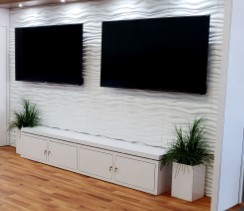A trade show booth isn’t just a space to display products; it is a strategic platform to foster relationships with clients, partners, suppliers, and even competitors. When leveraged effectively, a trade show booth can serve as a powerful tool for cultivating trust, establishing credibility, and nurturing relationships that drive long-term success.
This article explores how businesses can use trade show booths to create stronger industry relationships, covering booth design, engagement strategies, follow-up techniques, and the integration of technology and content marketing.
Understanding the Purpose of a Trade Show Booth
A trade show booth is often perceived as a static exhibition space, but it should be viewed as an interactive hub for relationship-building. The primary purpose of a trade show booth is to:
- Attract Attention: A well-designed booth draws attendees in and encourages meaningful conversations.
- Facilitate Engagement: Interactive experiences create opportunities for dialogue rather than just showcasing products.
- Demonstrate Expertise: Your booth should highlight your knowledge, reliability, and industry thought leadership.
- Build Trust: Relationship-building requires trust, and a professional, approachable presence at a trade show can reinforce credibility.
- Generate Leads and Partnerships: Trade shows allow you to identify potential clients, collaborators, or vendors in an environment conducive to networking.
By shifting the focus from mere product promotion to relationship cultivation, businesses can maximize the value of their trade show participation.
Booth Design: First Impressions Matter
The design of your booth is the first point of interaction with potential partners or clients. A well-conceived booth can communicate your brand identity, values, and industry expertise. Key design considerations include:
- Open Layout: Avoid barriers or clutter that prevent visitors from entering the booth. An open, inviting layout encourages spontaneous interactions.
- Visual Appeal: Use bold graphics, branded colors, and clear signage to catch attention. However, avoid overwhelming attendees with excessive visuals.
- Interactive Elements: Incorporate touchscreens, product demos, VR experiences, or live demonstrations. Interactive elements foster deeper engagement and provide talking points for staff.
- Comfortable Meeting Areas: Providing seating or a quiet corner allows for more in-depth discussions with key prospects or partners.
- Consistent Branding: Ensure your booth reflects your company’s branding across all materials, from banners to promotional items. Consistency reinforces professionalism and trustworthiness.
Remember, the booth itself is not just a display space—it’s the first impression of your company. A thoughtfully designed booth signals that you value quality and attention to detail, which can strengthen potential industry relationships from the outset.
Preparing Your Team for Relationship-Building
Even the most visually appealing booth will fall short without a well-trained team. Your booth staff are your brand ambassadors, and their ability to engage effectively can make or break the relationship-building process. Here’s how to prepare them:
- Product and Industry Knowledge: Staff should be well-versed in your offerings, competitors, and industry trends. They should be able to answer questions with confidence and authority.
- Communication Skills: Encourage active listening and conversational skills. Building relationships is about understanding others’ needs and demonstrating empathy.
- Engagement Strategies: Train staff to approach attendees warmly and avoid pushy sales tactics. Open-ended questions like “What challenges are you currently facing?” can initiate meaningful dialogues.
- Networking Etiquette: Staff should be adept at collecting business cards, connecting on LinkedIn, and following up professionally after the event.
- Team Coordination: Assign roles—some team members may focus on lead generation, while others manage product demos or facilitate deeper conversations with potential partners.
A prepared, personable team transforms a booth from a display space into a relationship-building hub.
Engaging Attendees: From Transaction to Connection
The key to using trade show booths for relationship-building lies in meaningful engagement. Rather than simply presenting products, your goal should be to create interactions that foster trust and mutual interest. Effective engagement strategies include:
- Interactive Demonstrations: Hands-on experiences allow attendees to engage with your products or services actively. Demonstrations provide natural conversation starters and show your expertise in action.
- Workshops and Mini-Sessions: Offering short educational sessions at your booth positions your brand as a thought leader. Topics should address industry trends or common pain points, providing attendees with valuable takeaways.
- Games and Contests: While fun, these should serve a larger purpose of sparking conversations and collecting leads. Games can act as icebreakers, particularly in crowded trade show settings.
- Storytelling: Share success stories, case studies, or personal narratives that demonstrate your impact in the industry. Storytelling creates emotional connections, which are crucial for strong business relationships.
- Listening and Personalization: Tailor your conversations based on the attendee’s role, interests, or challenges. Personalized interactions show respect and genuine interest, making your booth memorable.
Strong engagement doesn’t happen by accident. It requires intentional planning and active participation by your team.
Leveraging Technology to Enhance Relationships
Technology can significantly enhance the relationship-building potential of your trade show booth. Incorporating tech solutions can streamline interactions, capture data, and provide unique experiences:
- Lead Capture Systems: Digital tools can efficiently record visitor information, track interactions, and categorize leads for follow-up. This ensures no opportunity is lost in the post-show phase.
- Augmented and Virtual Reality: AR and VR experiences can demonstrate products in immersive ways, creating memorable experiences that spark conversations.
- Interactive Touchscreens: These allow attendees to explore product catalogs, company information, and case studies at their own pace while still facilitating discussions with staff.
- Social Media Integration: Encourage attendees to share their booth experiences online. Branded hashtags, live streams, and digital photo booths extend your reach and enhance engagement.
- Analytics Tools: Monitor which booth features draw the most interest. This data helps refine future engagement strategies and ensures your booth continues to evolve as a relationship-building asset.
When technology complements personal interaction rather than replacing it, it strengthens relationships rather than creating barriers.
Maximizing Networking Opportunities
Trade shows bring together an entire industry under one roof, making them ideal for networking. Your booth is the anchor point for relationship-building, but you should also engage in broader networking activities:
- Attend Industry Sessions: Participate in panels, workshops, and keynote sessions. These provide additional avenues to meet potential partners or clients outside your booth.
- Host Private Meetings: Invite key prospects or existing clients for one-on-one meetings near or within your booth space. Personalized attention deepens relationships.
- Collaborate with Other Exhibitors: Building strategic alliances with non-competing exhibitors can expand your industry network and create referral opportunities.
- Social Events and Receptions: Take advantage of trade show-sponsored social events to meet contacts in a more informal setting. Relationships built over casual interactions often prove enduring.
A trade show is not just an exhibition—it’s an ecosystem for building and nurturing meaningful industry connections.
Follow-Up: Turning Booth Conversations into Lasting Relationships
The work doesn’t end when the trade show closes. Follow-up is critical for converting initial interactions into long-term relationships:
- Timely Follow-Up: Reach out within a few days to express appreciation for the meeting. Personalized messages referencing specific discussions show attentiveness.
- Provide Value: Share relevant resources, case studies, or industry insights that align with the attendee’s needs. This reinforces your role as a trusted partner.
- Segment Your Leads: Categorize contacts based on relationship potential—clients, partners, influencers, or suppliers—and tailor your follow-up accordingly.
- Leverage Multiple Channels: Email, phone calls, social media, or even in-person visits can be used strategically depending on the type of relationship.
- Maintain Long-Term Engagement: Continue sharing valuable insights, invitations to webinars, or exclusive previews. Consistent communication nurtures relationships beyond immediate sales opportunities.
A thoughtful follow-up process ensures your booth interactions evolve into lasting industry relationships.
Measuring Success Beyond Sales
While immediate sales are a tangible metric, the true value of trade shows often lies in the strength of relationships forged. Metrics to assess relationship-building success include:
- Quality of Leads: Were the interactions meaningful, with potential for collaboration or partnership?
- Industry Influence: Did your booth position your brand as an authority or thought leader?
- Partnership Opportunities: Did the show result in new alliances, collaborations, or supplier relationships?
- Engagement Levels: How many attendees interacted with your booth through demos, discussions, or interactive elements?
- Follow-Up Success: Are contacts responsive, engaged, and open to continued conversation?
By evaluating success through the lens of relationship-building, companies can better understand and optimize the long-term ROI of trade shows.
Trade show booths are more than spaces to display products—they are dynamic platforms for fostering strong industry relationships. Through thoughtful booth design, strategic engagement, well-prepared staff, and technology integration, businesses can transform trade show participation from a transactional event into a relationship-building opportunity. Coupled with proactive follow-up and a focus on long-term engagement, trade show booths become essential tools for creating trust, credibility, and enduring connections within your industry.
The companies that excel at leveraging trade show booths are those that recognize the human element of business. They prioritize meaningful interactions, provide value beyond their products, and invest in relationships that extend far beyond the trade show floor. In doing so, they don’t just participate in an event—they cultivate a network that drives sustainable growth, influence, and industry leadership.




